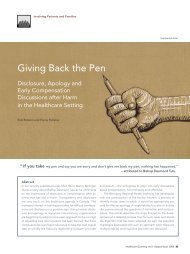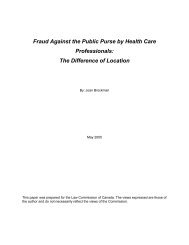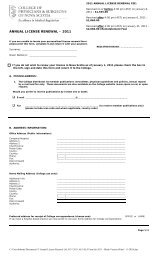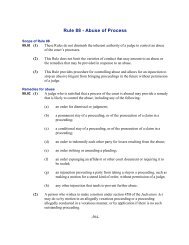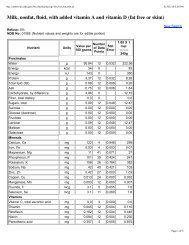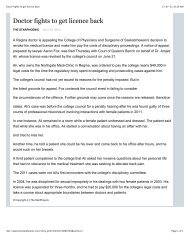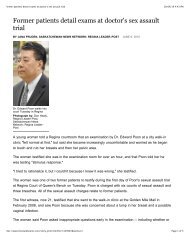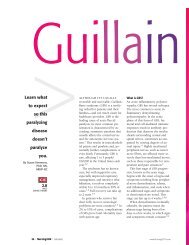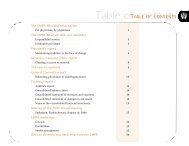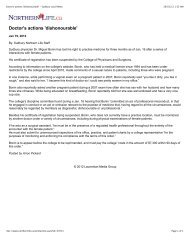Experiments That Changed Nutritional Thinking - TUUM EST
Experiments That Changed Nutritional Thinking - TUUM EST
Experiments That Changed Nutritional Thinking - TUUM EST
Create successful ePaper yourself
Turn your PDF publications into a flip-book with our unique Google optimized e-Paper software.
1030S<br />
SUPPLEMENT<br />
Two years later, McCollum and his graduate student Cornelia<br />
Kennedy suggested the provisional use of alphabetical terms<br />
for this lipin and other essential ‘‘organic complex(s),’’ using<br />
a prefix designating characteristic solubility. Thus for this essential<br />
factor(s) they proposed the term ‘‘fat-soluble A’’<br />
(McCollum and Kennedy 1916). Soon this gave way to the<br />
term ‘‘vitamin A.’’<br />
McCollum and Davis also focused on discovering the nature<br />
of the nutritional deficiencies of the cereal grains. Particular<br />
attention was given to the nature of the dietary deficiencies<br />
of rice. In their article were 42 growth charts (McCollum and<br />
Davis 1915). Each chart portrayed the growth for each rat in<br />
an experimental lot, the composition of the ration used, the<br />
kind of test substance (accessory) added, if any, etc. Some of<br />
the results are summarized in Table 1. In their introduction<br />
they stated in part:<br />
‘‘In the present communication we present experimental data<br />
showing the specific properties of polished and of unpolished<br />
rice as a food, and show the supplementary relationship between<br />
these and certain purified and naturally occurring foodstuffs<br />
. . . . These studies, in addition to extending our knowledge<br />
concerning the dietary position of rice, have contributed<br />
to our understanding of the factors involved in normal nutrition,<br />
especially as regards the unknown accessory constituents<br />
of the diet which have received so much attention in recent<br />
years in connection with the ‘deficiency diseases’, scurvy and<br />
beri-beri.’’<br />
FIGURE 1 Prepared from McCollum’s growth charts. This male A substantial proportion of the research was on ‘‘the supplerat<br />
received 3% cottonseed oil in its diet for the 7 wk of period 1 mentary relationship between certain extracts of naturally ocand<br />
then received 3% olive oil that had been shaken with soaps from<br />
curring foodstuffs and polished rice’’ in which most of the<br />
saponified butter fat. The dotted line represents the normal growth rate<br />
of these rats (from McCollum and Davis 1914, chart 2, rat B).<br />
extractants employed were water, ethanol and acetone<br />
(McCollum and Davis 1915).<br />
This was in regard to answering the question of the presence<br />
of ‘‘water-soluble accessory’’ in polished and unpolished rice.<br />
sive biological analysis of foods. In this paper they began by<br />
Water extract of wheat embryo was far superior to an acetone<br />
stating that:<br />
extract in supplementing a diet based on polished rice. McCol-<br />
‘‘During the past year we have been engaged in a study of the<br />
influence of the composition and quantity of the inorganic lum and Davis (1915) concluded that ‘‘such knowledge, when<br />
content of the ration on the growth of the rat. In this work available for a wide variety of foodstuffs must, we believe, be<br />
we have employed rations compounded of pure casein, carbowill<br />
promote health.’’ Thus this study contributed to the illu-<br />
of great value in the formulation of human dietaries which<br />
hydrates, and salt mixtures made up of pure reagents, and the<br />
same rations in which a part of the carbohydrate was replaced mination of all their studies on cereal grains. While their work<br />
by lard, with a considerable degree of success. . . .’’<br />
In their commentary on these germinal experiences with rats<br />
fed such rations they wrote:<br />
TABLE 1<br />
‘‘The fact that a rat of 40 to 50 grams in weight can grow<br />
normally during three months or more on such rations, then<br />
Growth of young rats fed polished rice with<br />
cease to grow but maintain its weight and a well nourished<br />
different supplements1<br />
appearance for weeks and then resume growth on a ration<br />
containing certain naturally occurring food-stuffs would lead<br />
Lot (no. of male and female rats)<br />
one to the belief that on these mixtures of purified food substances<br />
the animals run out of some organic complex which is 308 316 317 383 395<br />
indispensable for further growth but without which mainte- (5 M, 1 F) (6 M) (6 M, 1 F) (3 M, 2 F) (4 F)<br />
nance in a fairly good nutritive state is possible.’’ (See Fig. 1.)<br />
In this article they had shown that butter fat and eggs Approx. initial<br />
contain the ‘‘lipins’’ and that none exists in lard or olive oil.<br />
weight g 100 40 60 60 40<br />
Also, they showed that the organic complex was extractable Diet<br />
with ether. In 1914 they reported that the new fat-soluble Polished rice 96 91 91 — 82<br />
factor was transferred to olive oil by the following procedure: Unpolished rice — — — 88 —<br />
‘‘Butter fat was saponified with potassium hydroxide in alcohol.<br />
Rice polishings — — — — 10<br />
The resulting soap was dissolved in water and olive oil was<br />
Salt mix 4 4 4 2 3<br />
thoroughly emulsified in the soap solution. The olive oil was<br />
Egg albumen — 5 — — —<br />
of the same sample which had been tested on rats and found<br />
Casein — — — 5 —<br />
to be of no value in protecting them against decline on the<br />
Butter fat — — 5 5 5<br />
basal diet. The emulsion was then broken with ether, and the Approx. weight<br />
olive oil was recovered in that solvent. After evaporating the gain in 8 wk, g 0 or less 0–15 loss 65 50<br />
ether, the olive oil was found by a feeding test to have acquired<br />
the nutritive quality of the butter fat.’’ (McCollum and Davis 1 Based on data in five different growth charts selected from 42<br />
1914)<br />
published by McCollum and Davis (1915).<br />
/ 4p09$$0062 04-07-97 14:02:12 nutras LP: J Nut May Suppl<br />
Downloaded from jn.nutrition.org by on June 3, 2010



